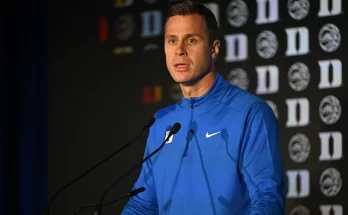The Indiana Fever are in chaos without Caitlin Clark as their offense falters and coaching decisions are made by
From the outset, the Fever entered 2025 with a sense of optimism rarely felt in recent years. Caitlin Clark’s arrival brought a fresh wave of hope. Her electrifying rookie season—marked by prodigious scoring and record-setting creativity—turned heads around the league. But that momentum has stalled. Clark has battled injuries, including a left quad strain sustained May 24 against the Liberty and a subsequent groin concern, limiting her to just 13 of Indiana’s 24 games before the All‑Star break Without her, the Fever have slipped into confusion, struggling to find identity or rhythm—factors that ultimately expose the failings of coaching, front office moves, and roster construction.
While Clark’s presence undeniably lifts the team—Indiana posted an 8–5 record with her versus 4–7 without (The Sun)—the absence issue runs deeper. Her playmaking, floor management, and pace are the engine of the Fever. When she’s sidelined, the offense sinks. Consider their worst offensive output in recent memory: a 58‑point flop in a Commissioner’s Cup game against Atlanta, marking their lowest scoring night since 2017 (SI). Their overall scoring average tumbled from 88.0 PPG to just 76.4 (SI). Meanwhile, fast‑break points dropped from 12.3 to a meager 3.8 per game (SI), and their PACE/40 plummeted from 84.12—second‑best in the league—to dead last at 76.90 (SI). When Clark isn’t orchestrating the offense, the Fever struggle, forced into half‑court sets that don’t harness their strengths.
These numbers translate into a tangible, stagnant look on court. Opponents feast on routine rotations, trapping, and collapses in the paint. A standout example: in a game without Clark, the Sparks built a 10‑point lead in the fourth quarter, and the Fever stumbled to a 85‑75 defeat due to stagnant offense and poor rebounding ). Aliyah Boston, the team’s second key cog, was ready in the post but never got the ball consistently—despite shooting 62% entering the game, she went just 4‑for‑13 that night (Ink on Indy). When the ball doesn’t move through Clark or Boston, the offense glitches—an issue even veteran guards like Kelsey Mitchell .
This suddenly highlights a fundamental flaw: the roster lacks players capable of stepping into playmaking roles. The decision to rely on backup point guard Sydney Colson proved problematic. In one matchup against Washington, Colson recorded only three assists and as many turnovers—an unsustainable trend (SI). Meanwhile, depth issues surfaced. Injuries to Cunningham and Colson, combined with Clark’s, forced the Fever to sign Aari McDonald on a hardship contract (Wikipedia). That patchwork bench is no substitute for a dedicated facilitator capable of maintaining pace or spacing in the offense.
Notably, though, the Fever aren’t completely helpless without Clark. They’ve posted a 3–1 record in four of her absences (Athlon Sports, Wikipedia), including a Commissioner’s Cup win against the Aces—proof that their talent can still win games. Former coach Carolyn Peck went so far as to say Indiana looks “more dangerous” without Clark because of decreased ball dependency and increased offensive freedom (Athlon Sports). But that’s a limited silver lining; those wins mask deeper issues that a more flexible roster might handle better.
For most of the season, offensive stagnation without Clark has been the greatest shortfall. Reddit fans have been brutally candid:
Coaching decisions have also drawn criticism. Head coach Stephanie White committed heavily to implementing Clark’s up‑tempo style but pivoted mid‑season toward half‑court structure in Clark’s absence (EssentiallySports). She started rookies like Bri Turner in critical matchups—labeling it a “matchup thing”—but Turner played just six minutes and provided little spark (EssentiallySports, SI). Her occasional absences for personal reasons furthers an impression of instability (TalkSport). Meanwhile, half‑court sets remain uninspired, predictable, and lethargic—characteristics opponents efficiently exploit.
Defensively, the Fever have regressed as well. They allow frequent interior breakdowns and fail to contest or finish under the basket—qualities that persist even during wins (EssentiallySports, Ink on Indy). Redditors lamented relentless poor rebounding, especially by guards crashing the glass while bigs drift (Reddit). This highlights a lack of structure and poor rotation—an area White must adjust to maximize the team’s potential.
Behind Clark, Aliyah Boston has emerged as Indiana’s stabilizing force. She’s elevated her game across the board: averaging around 16 PPG on 56% shooting, and posting career‑high usage and assist rates (SBNation.com). In the five games during Clark’s absence before the break, Boston averaged 17.5 PPG and 7 RPG (SBNation.com). She answered with a historic performance against Liberty at Barclays Center, scoring 31 in one of those games (SBNation.com, NetsDaily). That delivered a tangible glimpse of what the team could look like if built around her post capacity.
Still, Boston’s emergence has not completely offset the dysfunction. When shots stall out of the post, the team lacks the spacing and ball movement to make defenses pay. Reducing reliance on dribble hoppers like Clark or Mitchell and generating multiple playmaking options is essential. As Reddit commenters suggest, Ivy roles—double screens, flare actions, off-ball movement—must be executed, not just conceptually planned (Reddit, Reddit).
The Fever’s story is further complicated by off‑court issues. DeWanna Bonner’s short‑lived comeback ended with her departing mid‑season due to “personal reasons” and dissatisfaction with the team’s fit (Wikipedia). That abrupt exit robbed the Fever of a veteran leader ideally suited to mentor younger talent and provided offensive versatility. Meanwhile, team president Kelly Krauskopf faced backlash for comments that downplayed Clark’s role and culminated in deleting her X account amid fan uproar (Athlon Sports). Public relations mishandlings have diverted attention from on-court fixes to damage control.
Media narratives reflect this internal turmoil. Clark’s non‑play during the All‑Star break saw national TV ratings drop by 55%, cementing her stature as a league driver (TalkSport). SportsKeeda captured fan despair after another home loss:
The path forward is clear but steep. First, coaching must refocus on structuring the offense around Clark and Boston’s strengths. That means fast‑tempo sets, aggressive pick-and-rolls, spacing for shooters, backdoor cuts, and clear post entries. Defensive plans must emphasize paint protection and rebounding schemes, especially targeting weak-side help and box-outs by guards.
Second, roster adjustments are needed. If Clark is out long-term, acquiring or prioritizing another ball-handler is non-negotiable. Veteran creators with vision—guards unafraid to pick it up—must complement the post-up options. The departure of Bonner highlights the danger of unbalanced roles and insufficient vet rotation.
Third, rebuild organizational strategy. Public communication must align with on-court promise. Acknowledging Clark’s impact, as well as Boston’s and Mitchell’s rising leadership, will help repair fan trust. Transparent timelines and investment in player development (e.g. health protocols) signal a coherent vision.
Finally, accountability across the culture must be embraced. White’s strategic flexibility is a start—but execution under pressure and close-game discipline must improve. Leaders in the locker room need roles defined clearly. As one Redditor wisely pointed out: players need clear coaching beyond generic motivational slogans (The Sun).
In total, this is not Clark’s collapse—it’s a symptom of systemic failure. Indiana’s chaos without her is tied to unstable coaching, misconstructed roster, and organizational misalignment. The talent is there: three All‑Stars, dynamic youth, and a rising post star. But they remain underdeveloped. The Fever are at a crossroads: build clarity around Clark‑Boston synergy, define utility rotations, shore up defense, or settle into dysfunction.
This second half could still be meaningful—but only with structural overhaul. Fast-paced offense, smart spacing, and identity clarity are prerequisites. Without them, this season risks ending as another case of squandered promise. The Fever need more than a savior—they need a plan. And that plan begins with aligning around their best players, consistency from the bench, and coaching that adapts. Their future depends on it.


